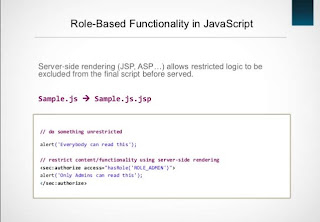RIA - A new world of possibility ready for the Enterprise.
.Architecture
.mature frameworks and libraries
.process and standards
Rich Internet Applications:
.Load main page once
.Dynamically replace content in response to user interaction
.javascript central to UI Logic
Traditional MVC with RIA:
.UI Logic in view and client-side components
.Views are specific to one UI
.View-slow
RIA without MVC:
.Client-side components(javascript)
.consume Enterprise API directly (SOAP)
.API may not fit UI needs
RIA with Slim MVC:
.MOdel/Controller are used to expose a UI-specific API (JSON,REST etc) That can be consumed by
different UIs.
.ByPass controller when possible,avoid views
Developing and Maintaining Javascript:
.Limited error detection by IDE
.Difficult refactoring
.Different coding styles
.Skill sets
Logging:
Log to Browser console or web page.
.Javascript APIs
Log to server File
.Call a Logging Service via AJAX
RIA technology:
.Architecture
.mature frameworks and libraries
.process and standards
Rich Internet Applications:
.Load main page once
.Dynamically replace content in response to user interaction
.javascript central to UI Logic
Traditional MVC with RIA:
.UI Logic in view and client-side components
.Views are specific to one UI
.View-slow
RIA without MVC:
.Client-side components(javascript)
.consume Enterprise API directly (SOAP)
.API may not fit UI needs
RIA with Slim MVC:
.MOdel/Controller are used to expose a UI-specific API (JSON,REST etc) That can be consumed by
different UIs.
.ByPass controller when possible,avoid views
Developing and Maintaining Javascript:
.Limited error detection by IDE
.Difficult refactoring
.Different coding styles
.Skill sets
Logging:
Log to Browser console or web page.
.Javascript APIs
Log to server File
.Call a Logging Service via AJAX
RIA technology:
- Partial screen updates
- Asynchronous communication
- Server push
- Widgets supporting direct manipulation
- Multiple coordinated windows
- Modal dialogs
- Menus
- Keyboard navigation










Qdexi Technology offers comprehensive RIA development services, crafting dynamic and engaging web experiences. With expertise in cutting-edge technologies, Qdexi creates interactive interfaces, seamless navigation, and responsive designs, enhancing user interactions and satisfaction. Their RIA solutions redefine web applications, delivering innovation and functionality in every click.
ReplyDelete